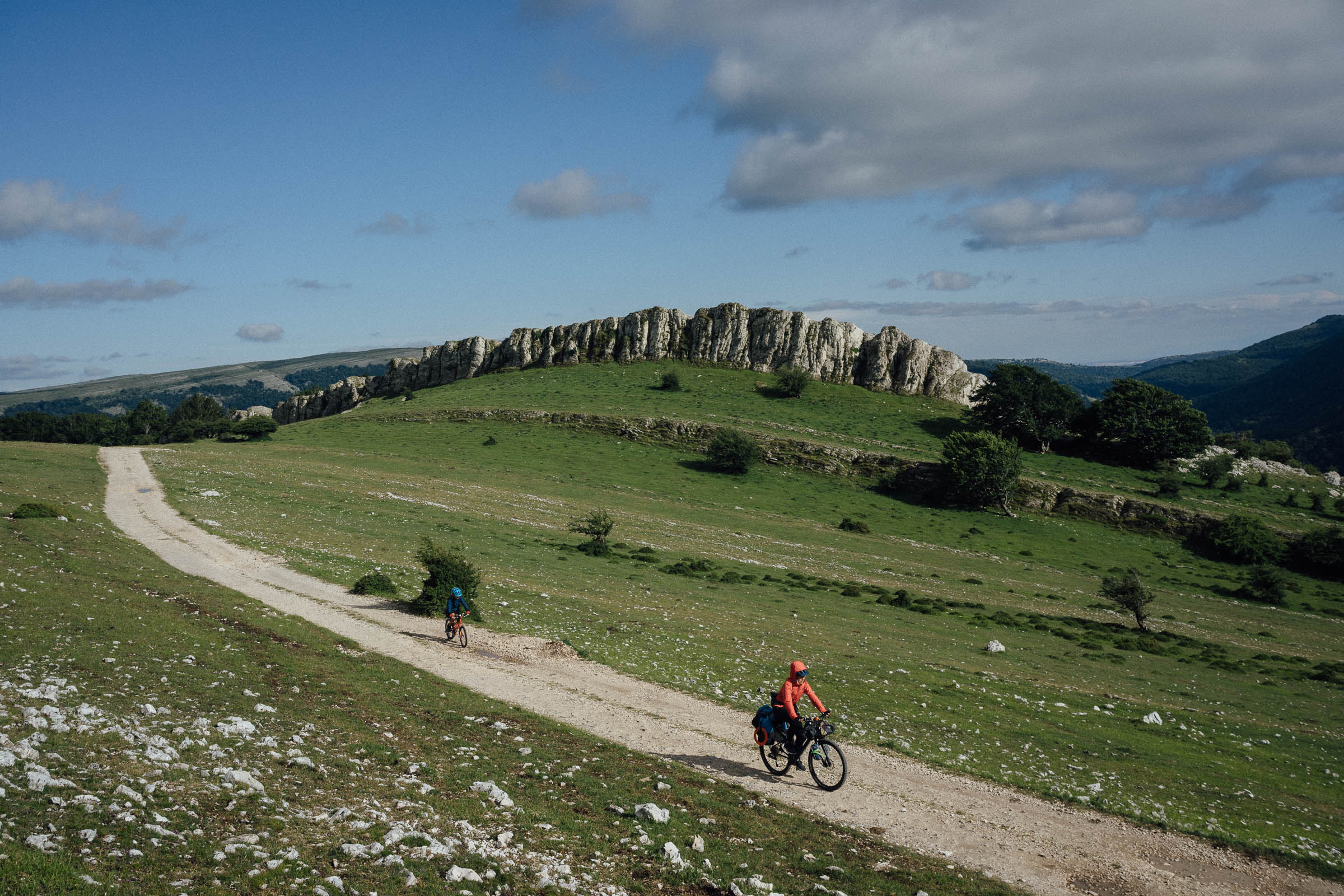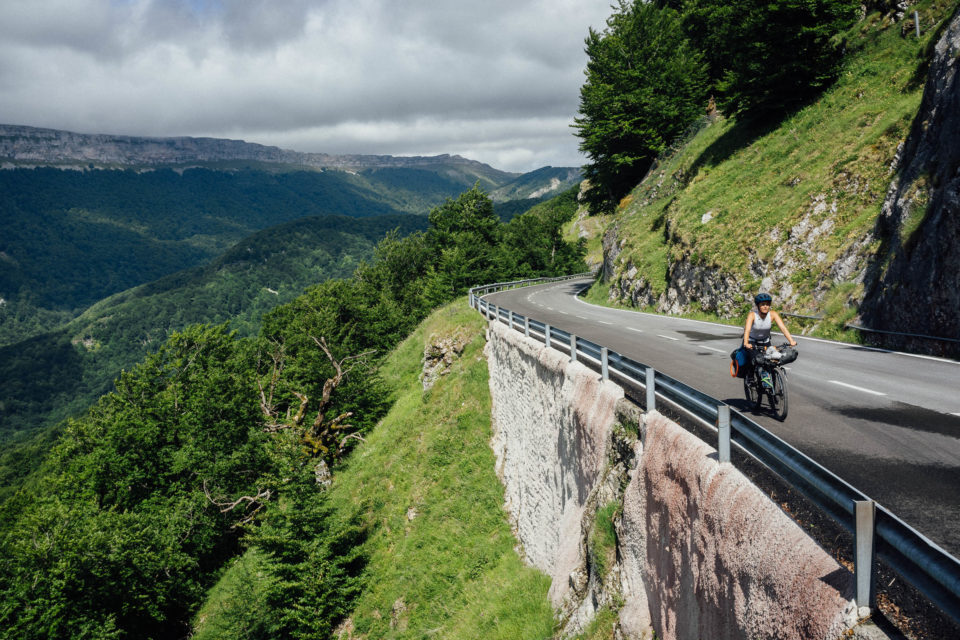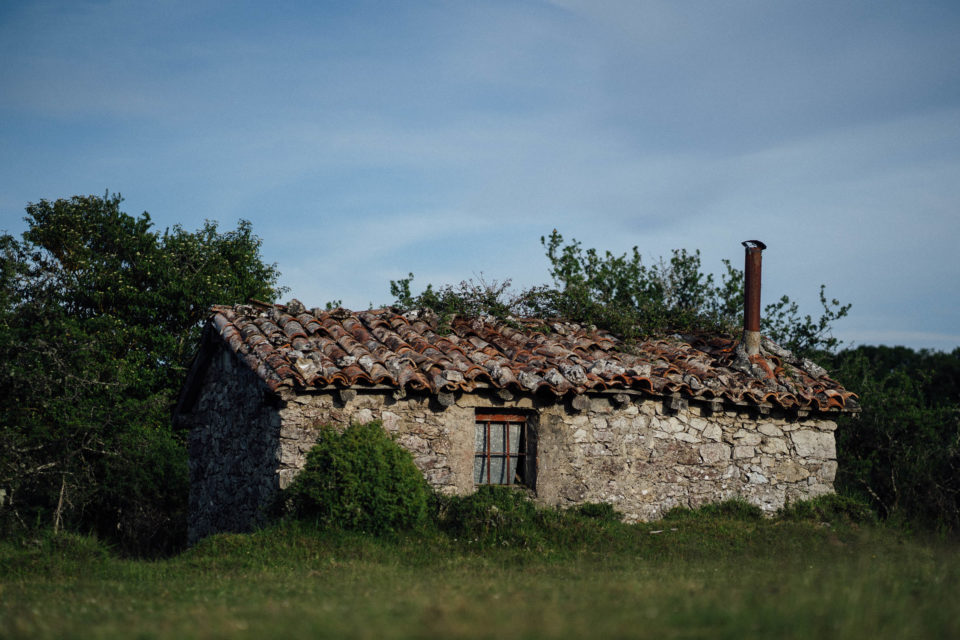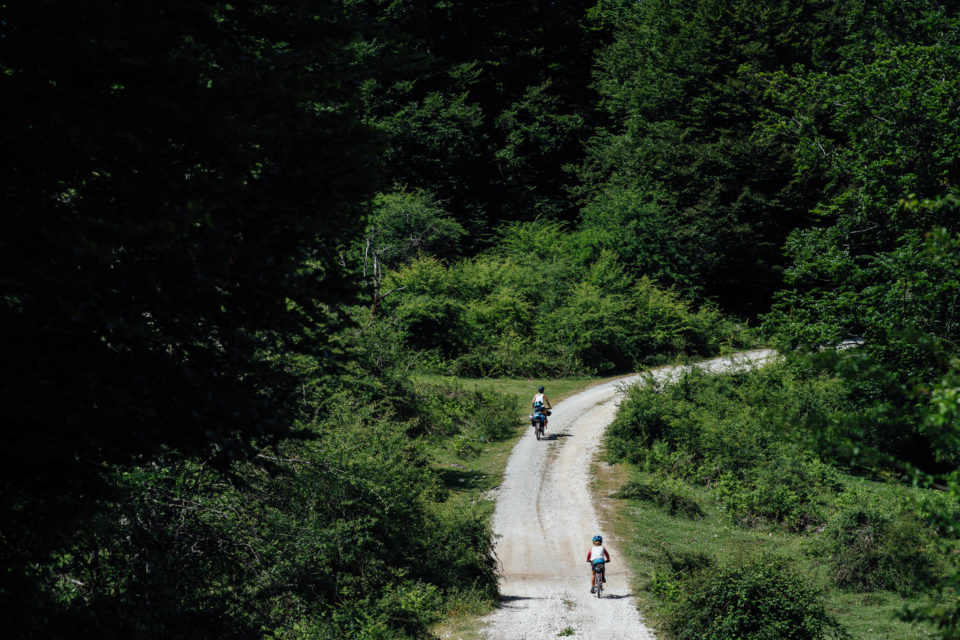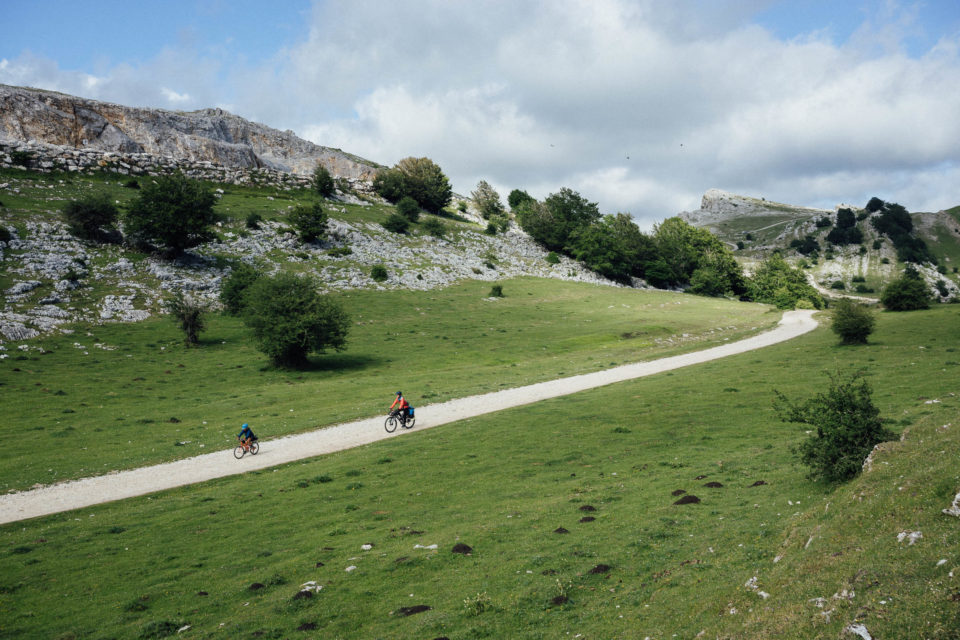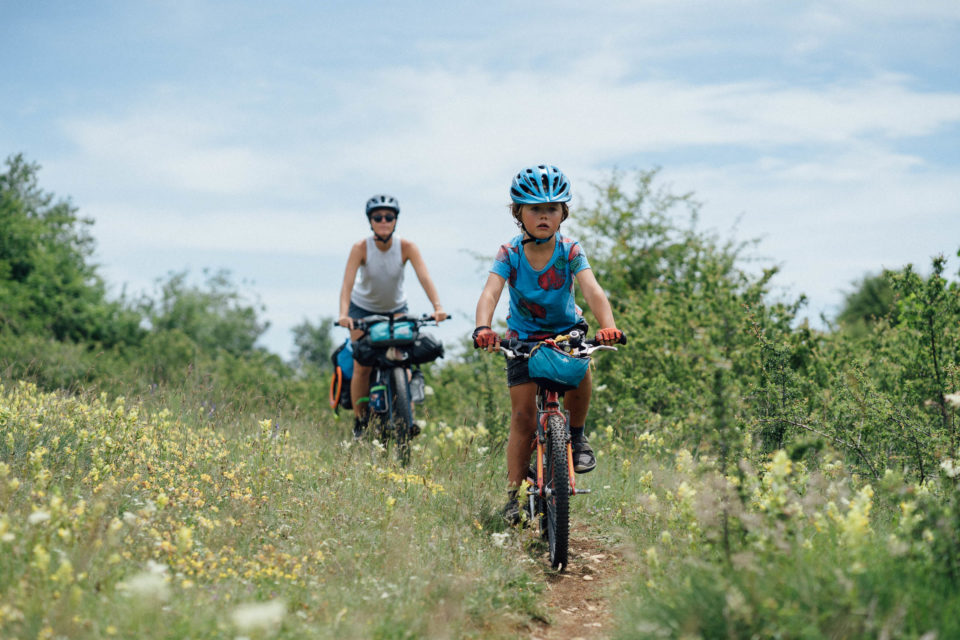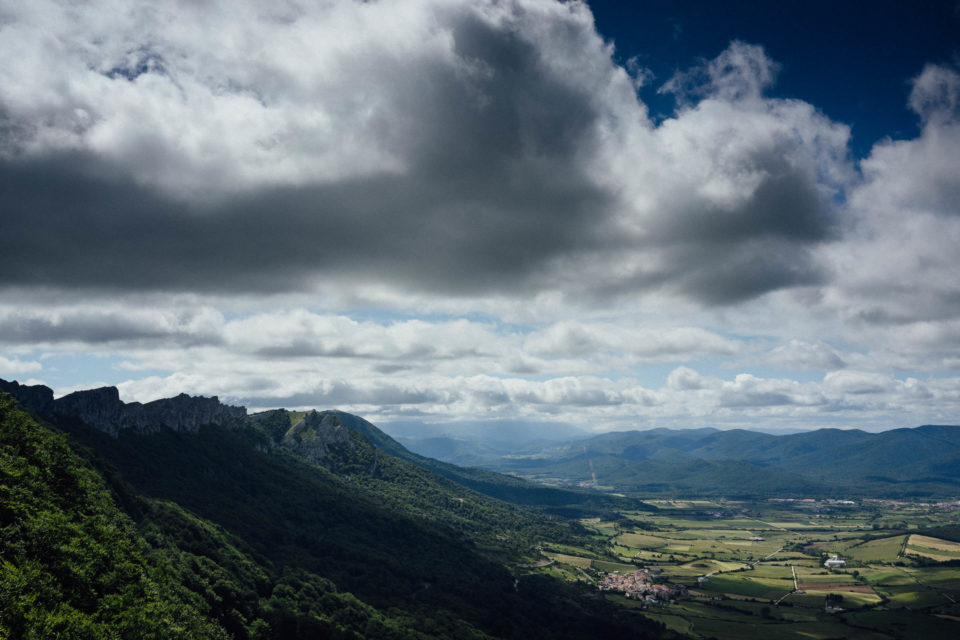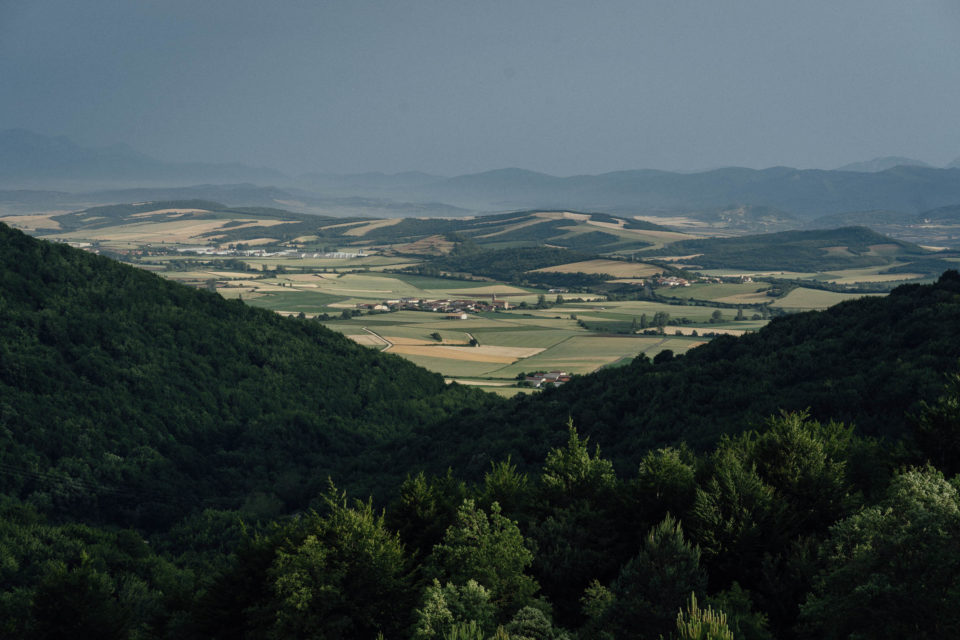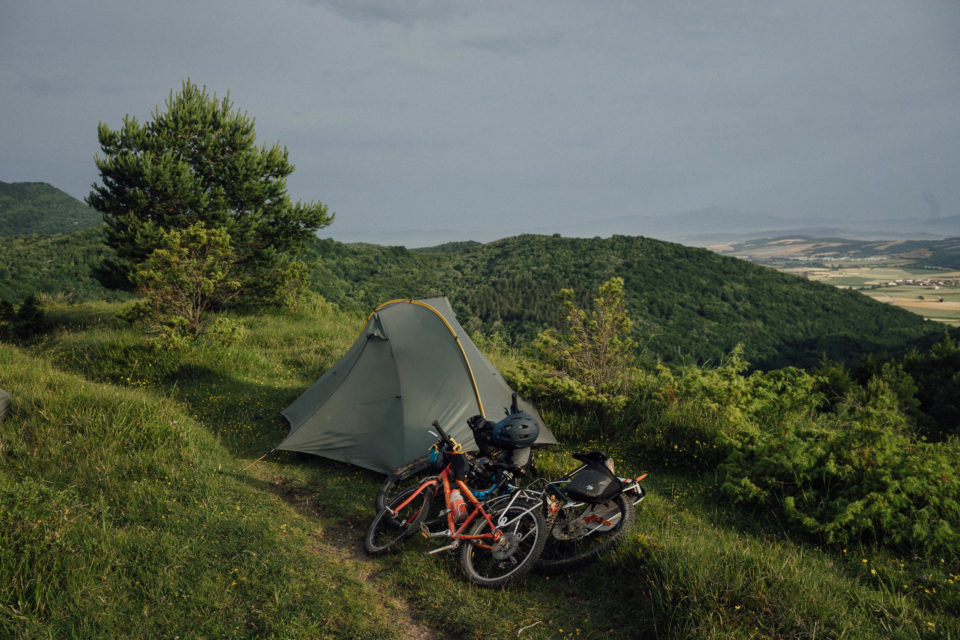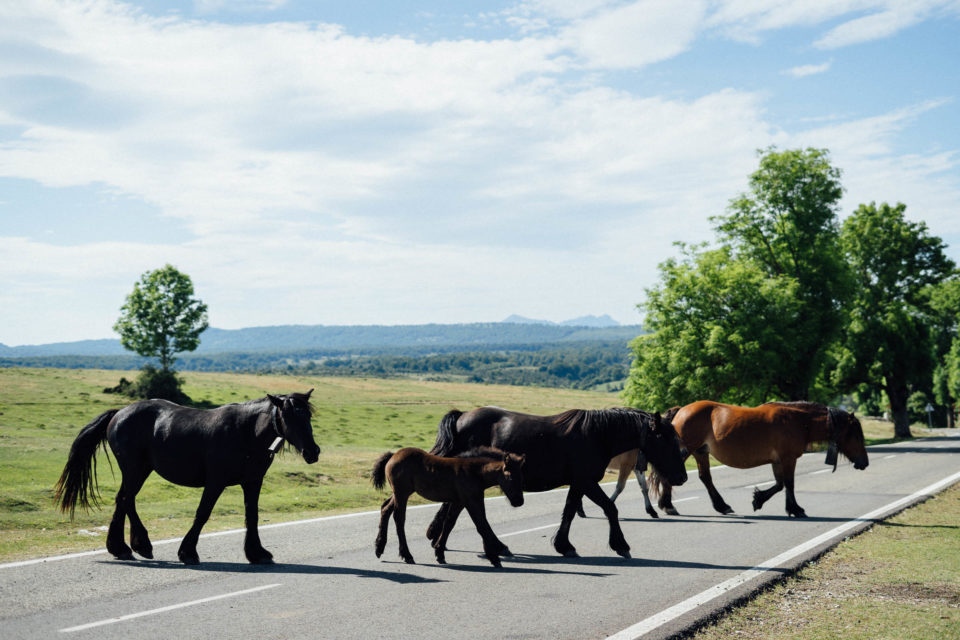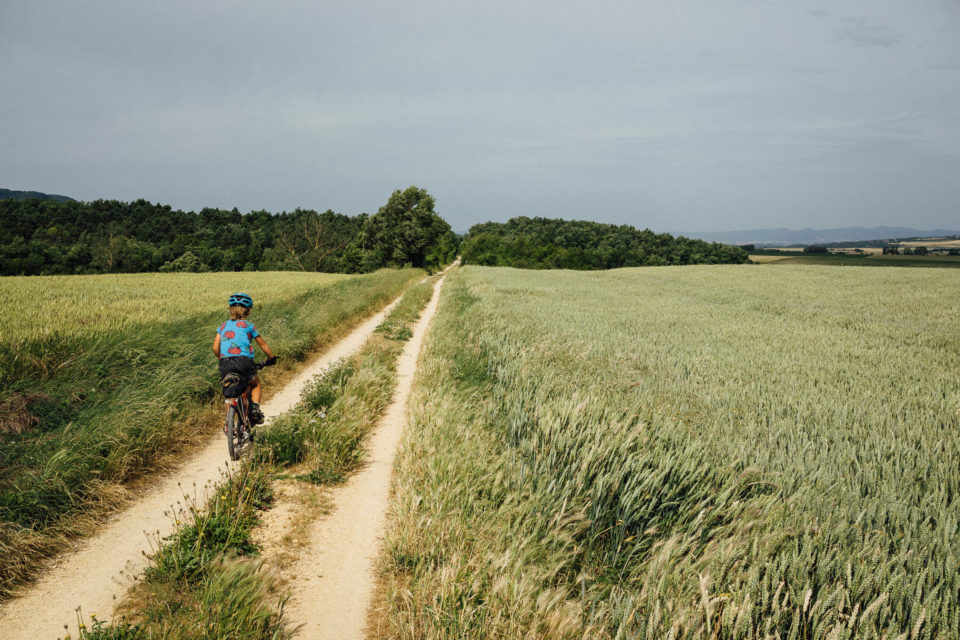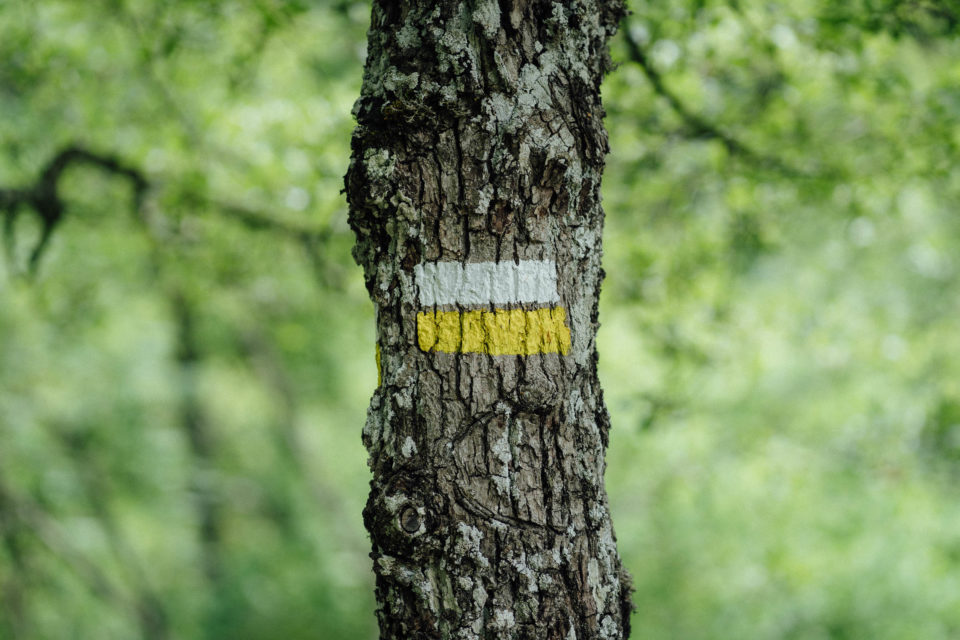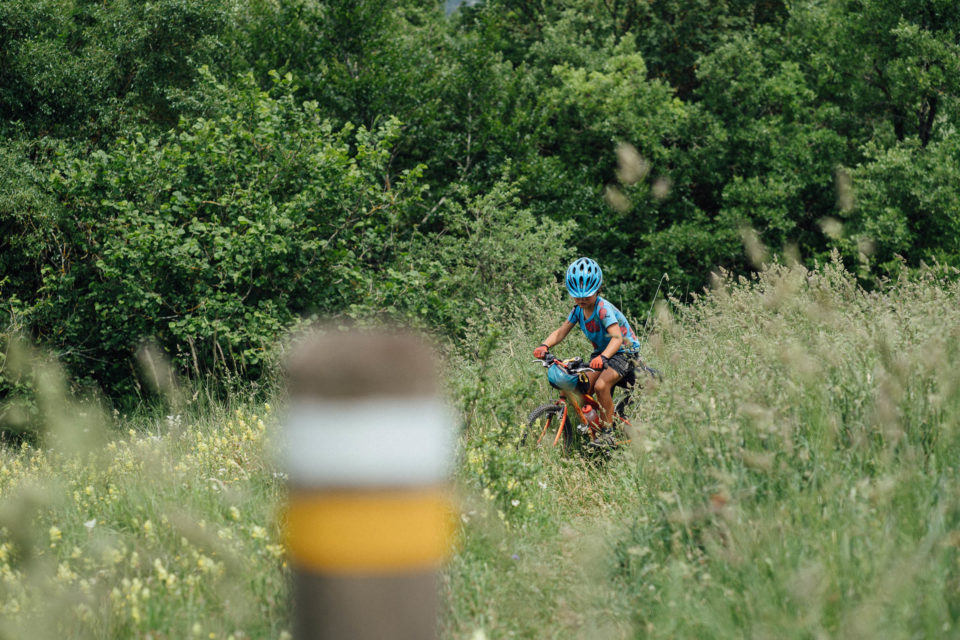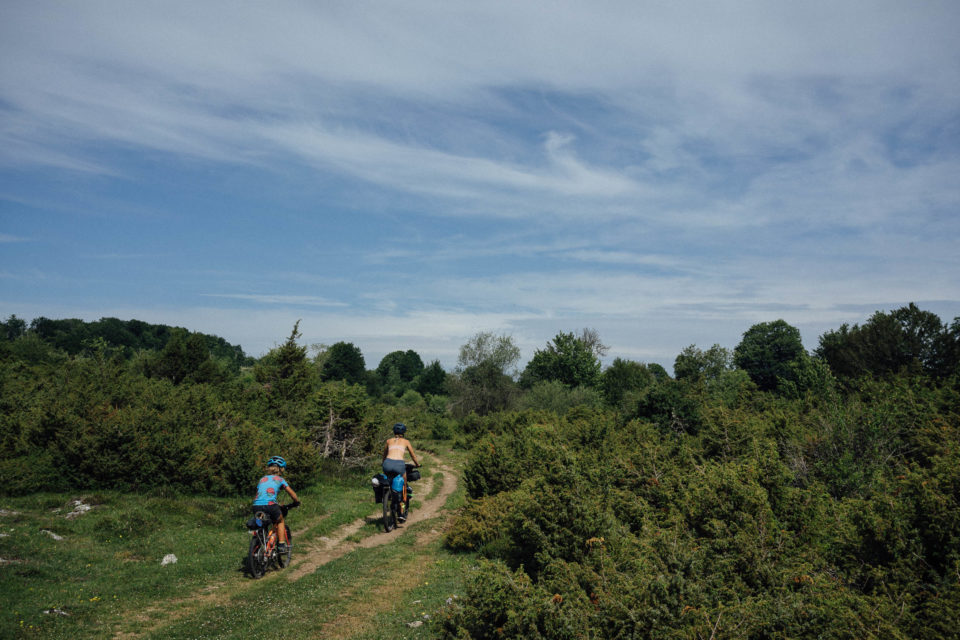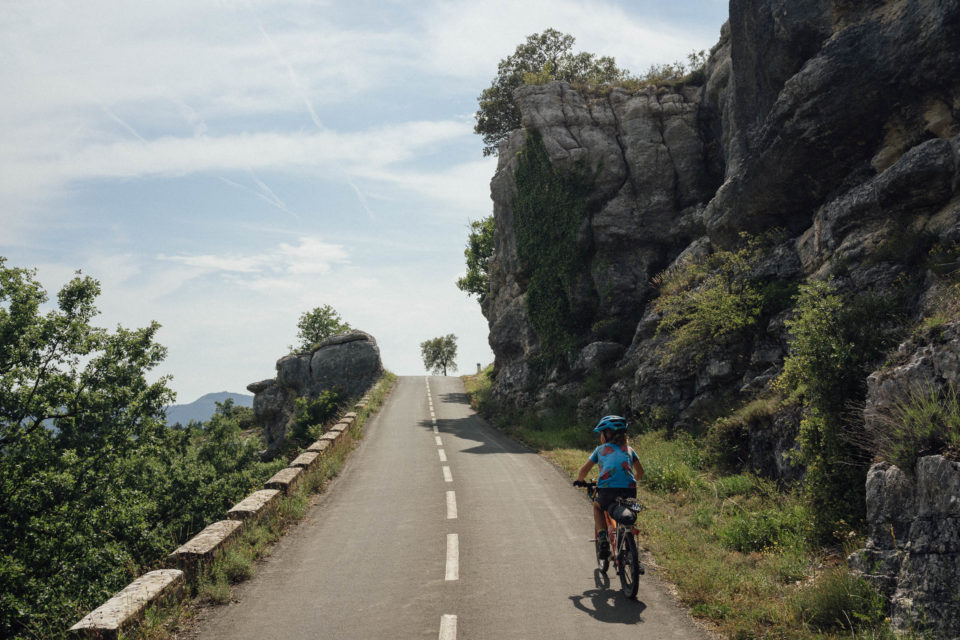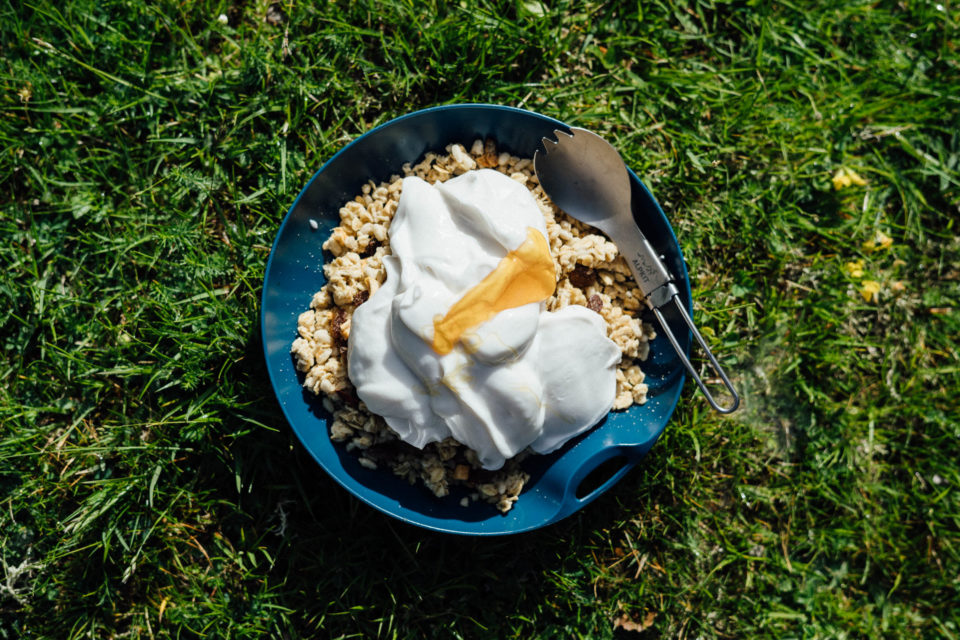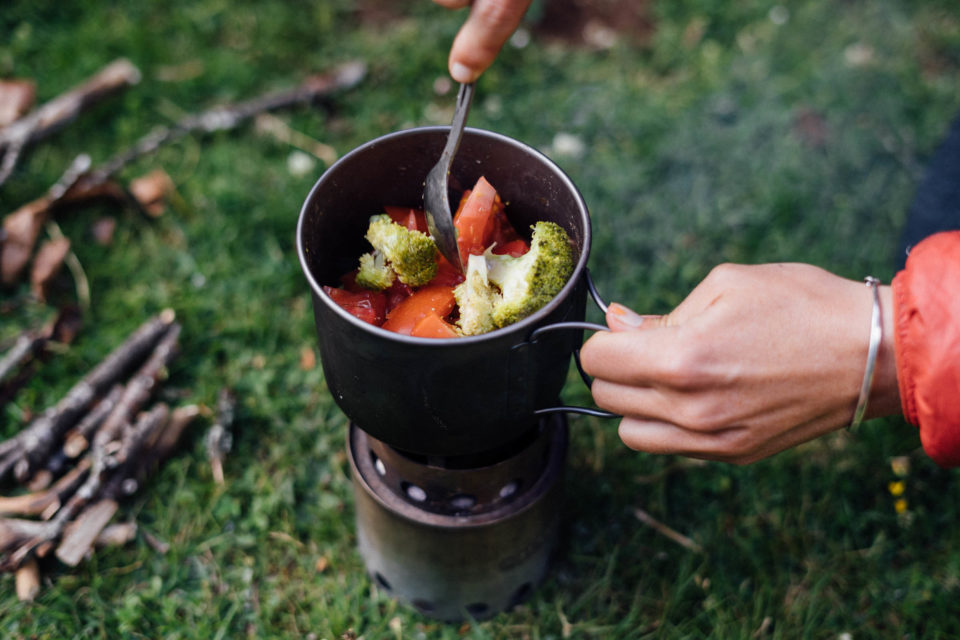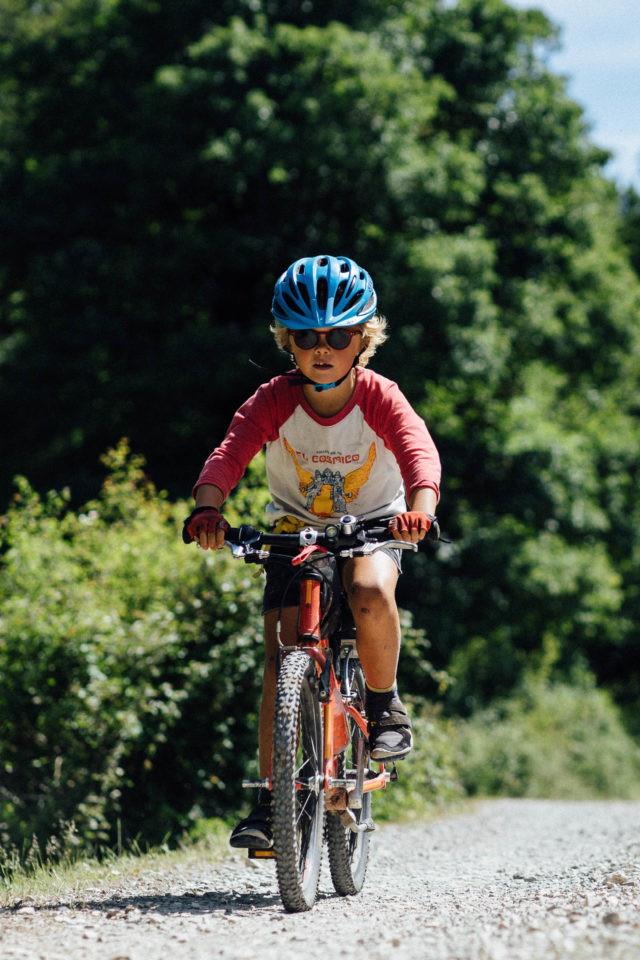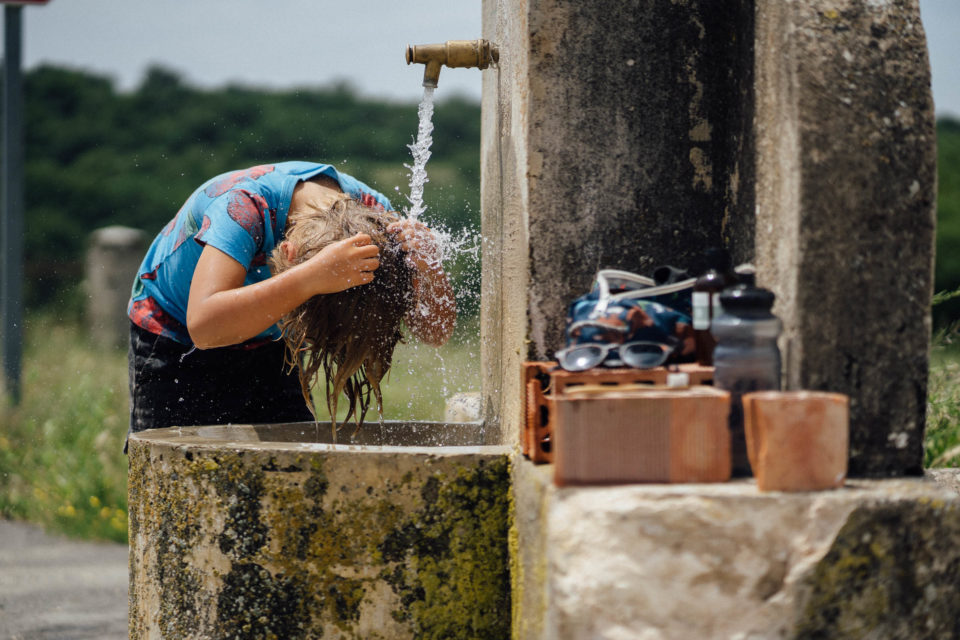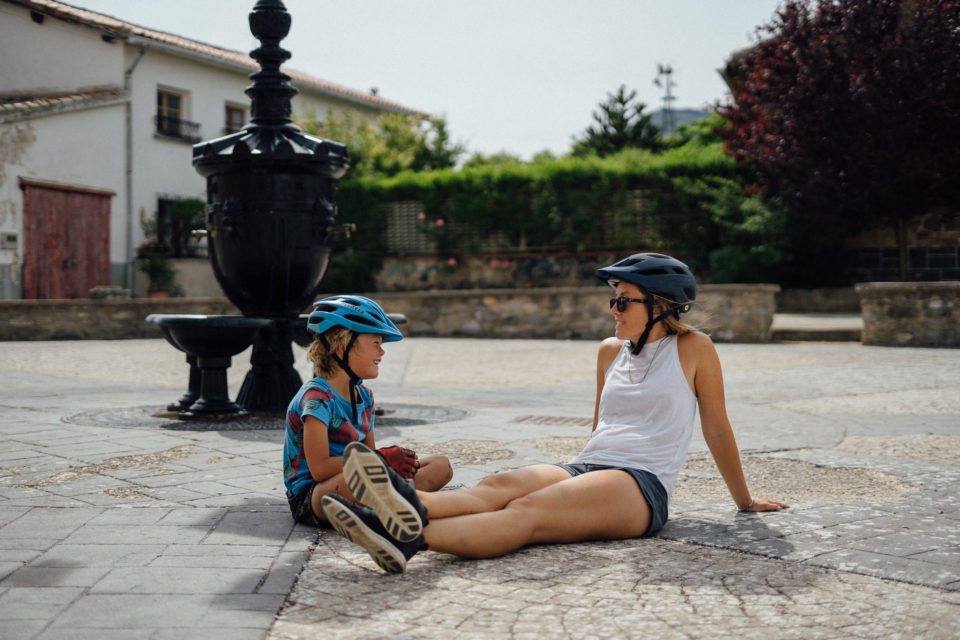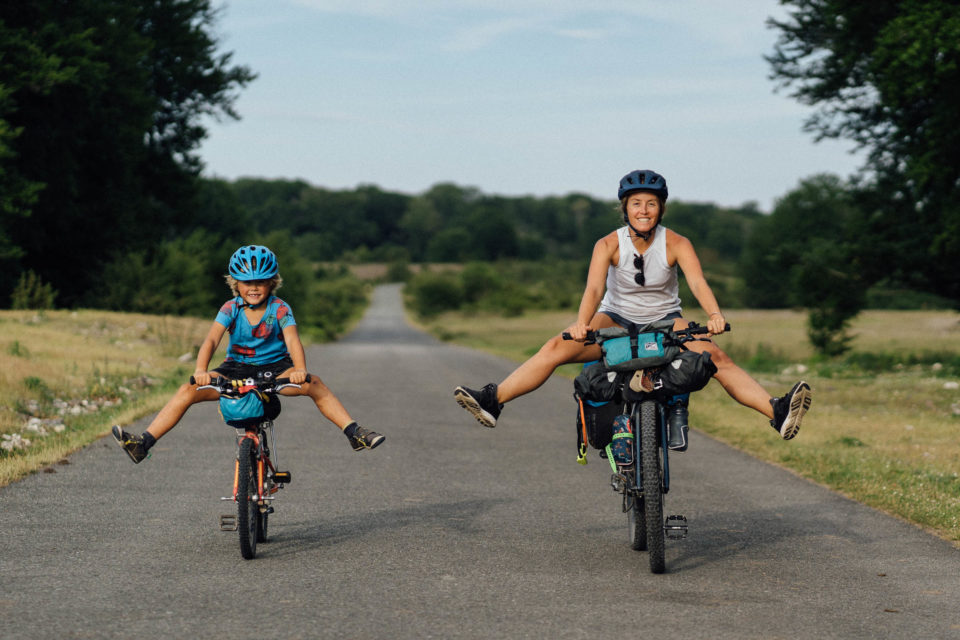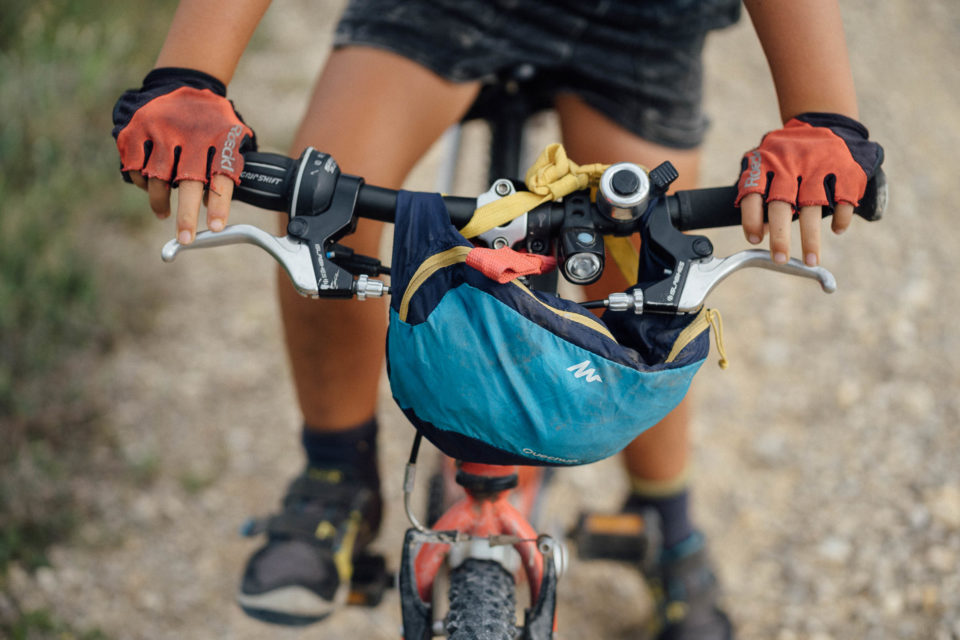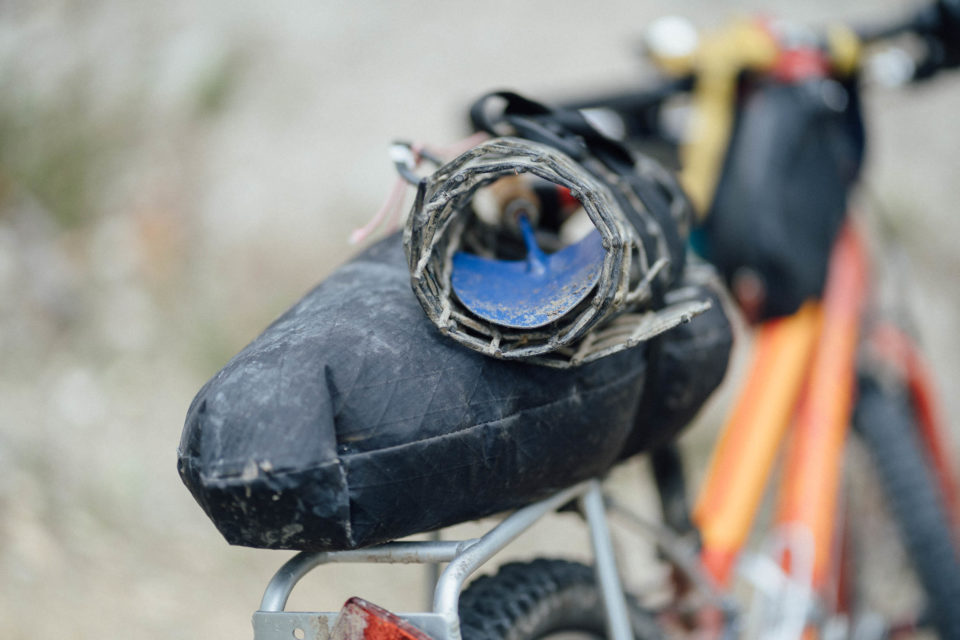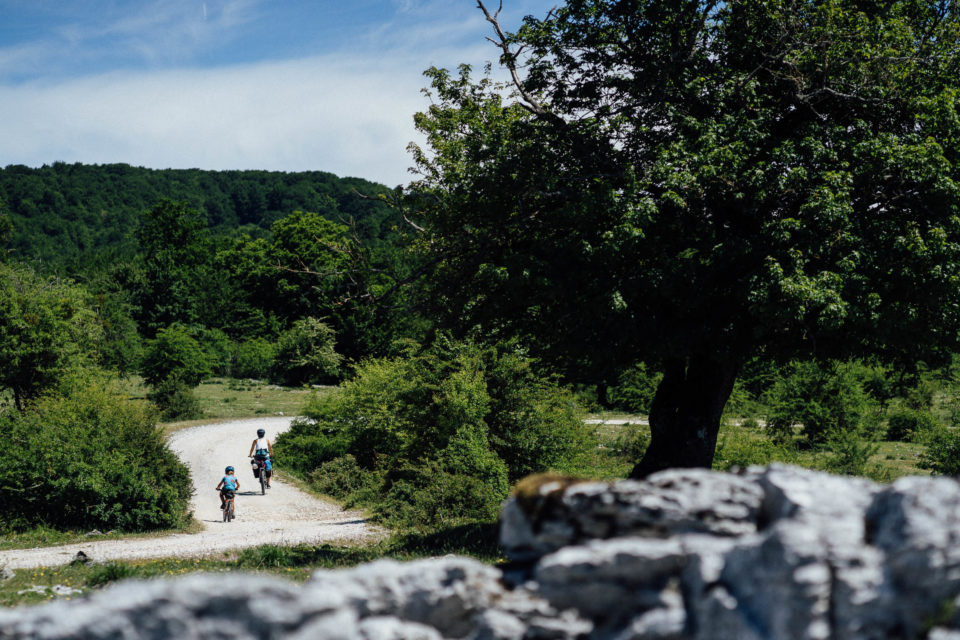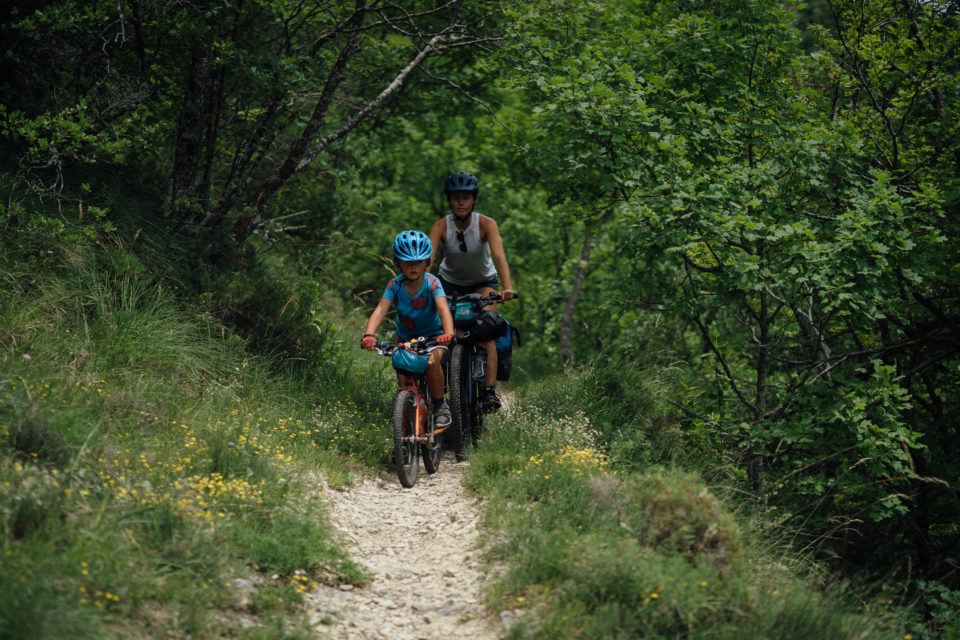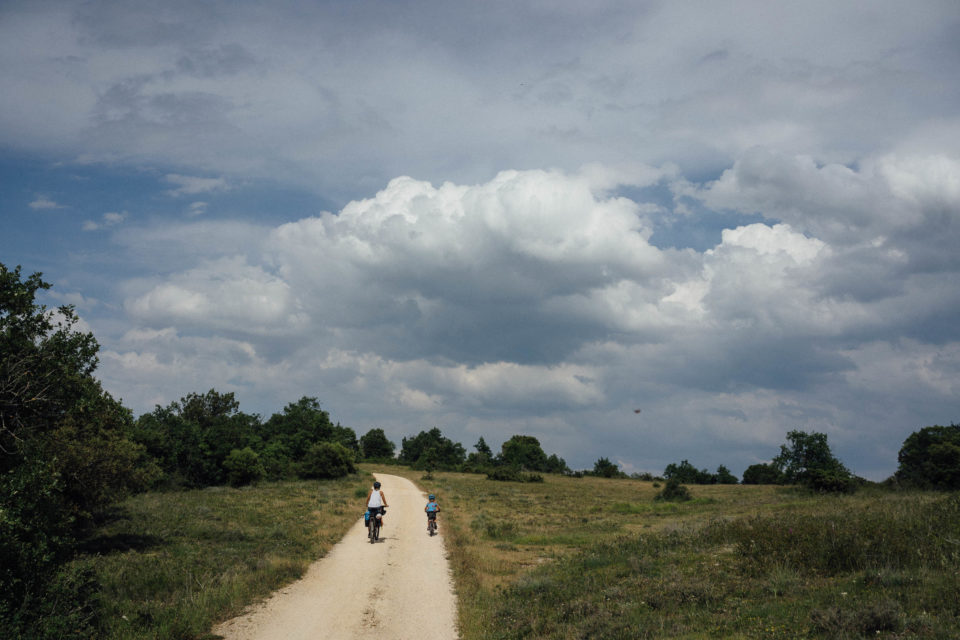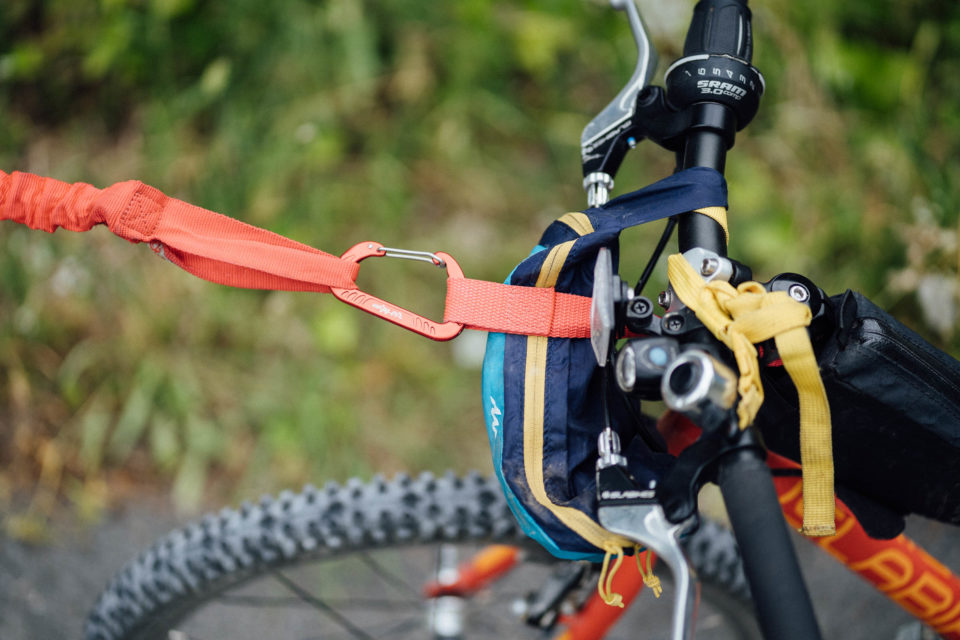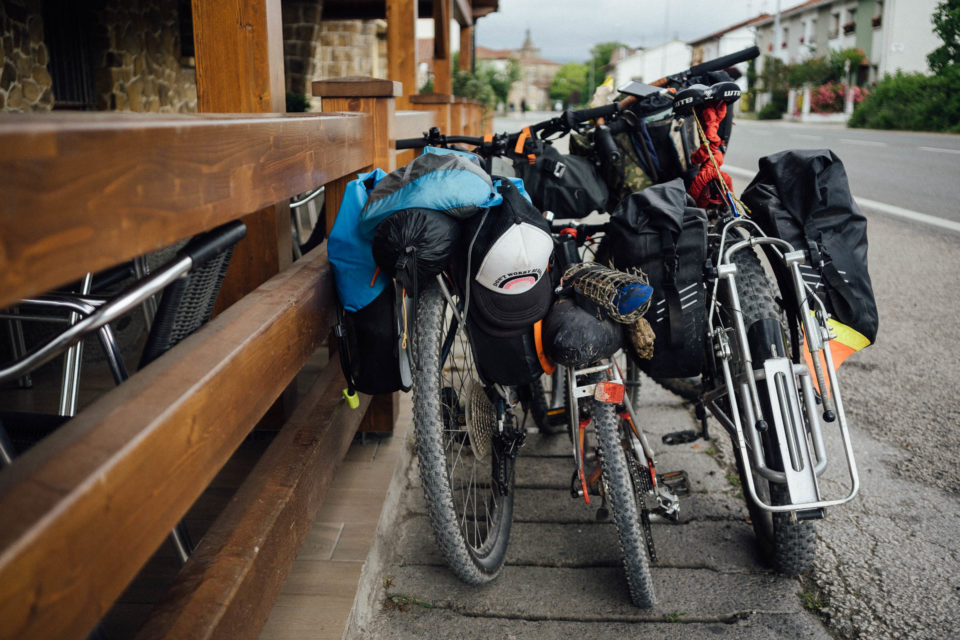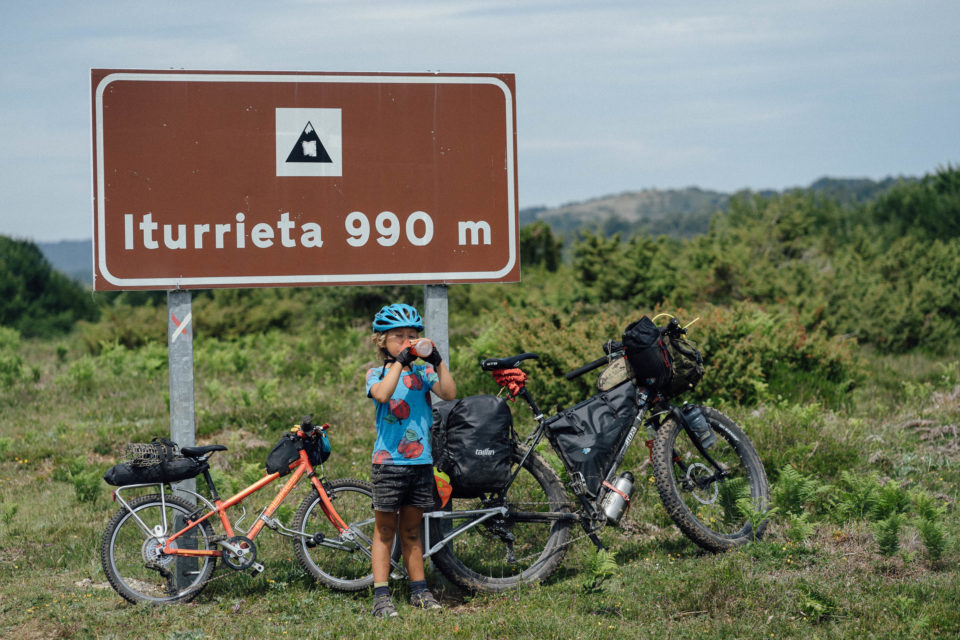A Mini Vuelta de Vasco; Sierra de Urbasa with a child
Share This
Inspired by the Vuelta de Vasco bikepacking route, Cass and his family head off to the Basque Country to bite off a chunk of the ride, crossing Spain’s Sierra de Urbasa in western Navarre by way of high plateaux, lush forest, Vías Verdes, and druid stones. Here’s some insights into the nuts and bolts of the trip, along with six-year-old Sage’s full packlist, details of his rig, and their core family camping gear…
Picking the right route is key to the success of a family bikepacking trip. A sense of challenge, a dose of discovery, some off-bike activities, and a few character-forming experiences are important ingredients to a well-rounded journey. But choose one that’s too hard and risk your family being dissuaded from future two-wheeled adventures…
In fact, we only decided to bikepack in the Spanish Basque Country after discovering that the Vuelta de Vasco – featured on this site – had a relatively modest ‘5’ as its difficulty rating. Aside from fine local fare, I noticed that it also promised Vías Verdes, railway lines converted into bike paths. So, I dropped route designer Lars Herring a line to find out if there was a section in particular that he’d recommend for a family. “The Sierra de Urbasa. After the first big climb, it’s relatively flat. And there’s lots of scope for wild camping,” came his reply.
‘Relatively flat’ of course, is just that. Relative. I doubt Lars has ridden with a six-year-old, to whom even bumps in the road are amplified by his four-foot stature. But still, Lars’ words were encouraging to hear, so after a couple of weeks of mellow riding along Euro Velo 1, we set the 100 km crossing of the Sierra de Urbasa as our final challenge. It would be our glorious finale before taking the slow ferry back from Bilbao to the UK.

Much of our family riding takes place in New Mexico and the American Southwest. Although Europe can’t match the States for space and legal wild camping, it does boast a few aces up its sleeve: impressive cycling infrastructure in many of its cities, a general respect for cyclists, and an extensive web of well-maintained public transportation options. All of these factors are a considerable help to those planning a family bikepacking trip, largely because removing cars from the equation makes for a much more relaxing experience, especially when kids are involved. Spain’s Basque region certainly ticks all the boxes in this regard.
In our case, we were able to catch a train from San Sebastian to Altsasu, our starting point, and a short ride away from connecting with the route. Then, once we’d crossed the Sierra de Urbasa a few days later, it was a painless process to catch a bus from Vitoria Gastaiz to Bilbao. Such is the cycling infrastructure in the Basque Country that we could even explore Bilbao without fearing for our lives, bookended with another manageable ride (apart from the last hectic stint) to the ferry port. These bike-friendly connectors make all the difference when it comes to family bikepacking, where tussling with heavy traffic in the company of delicate family members serves as a stark reminder of our vulnerability on the road. They’re especially useful when gear often includes trailers, or tag-a-longs, or various cumbersome devices aside from the bikes themselves. Try turning up to a Greyhound bus with such an entourage!

Sage the Hillclimber
As for the riding, it was exactly what we’d hoped for. Yes, it was largely easy going, especially from the perspective of an experienced bikepacker. But there was no shortage of climbs, which gave the trip its shape, its views, and its sense of grandeur, especially after the sedate riding that preceded it. In fact, seeing Sage winch up a particularly long and gruelling forest climb on our penultimate day was one of the most memorable moments for this bike-obsessed father. I was sure it would be too hard for him. There was the heat, for one. It came at the end of a long day in the saddle. And it was mined with awkward rocks. I didn’t want him to feel too much pressure, so I suggested it would be best to walk. But he’d set his sights on riding to the top. Once he set off, Nancy, normally not prone to be a ‘cheerleading mom’, encouraged him to throw down the hammer and was yelling, “You can do this! Keep going, you can do it! Come on Sage!” I could just imagine his little heart racing as he dug in deep.
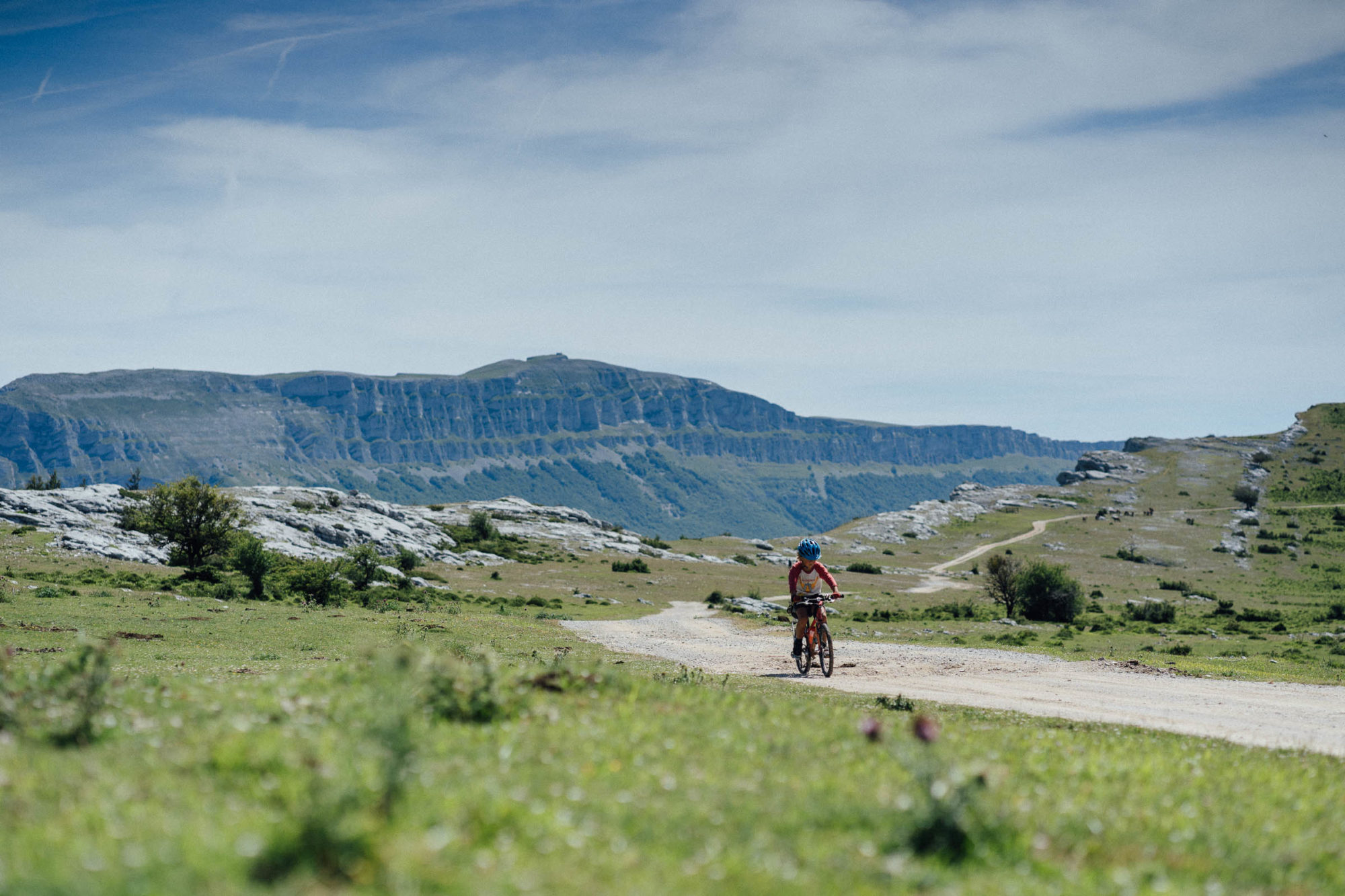
Upwards and upwards he pedalled, tacking this way and that to soften the gradient the climb, as I watched in awe. And lo and behold, he made it! At the crest, he stooped his head over the bars dramatically; the classic bike climber’s pose we all know so well. He was out of breath but triumphant. In fact, during the whole day, he’d been holding pace with Nancy. Where she got off and pushed, he insisted on riding, even if it meant pausing regularly in pools of shadow, a respite from the oppressive heat. Later, as they were both eyeing up a particular climb, she told me how he looked at her and said, “Mama, I think you can do this.”
I’d add that I’ve always been wary of being the ‘pushy bike dad’ and have tried to let Sage’s sense of two-wheeled enjoyment grow naturally. We have, however, used bikes for many of our holidays since he was young, and I take him to school by bike too, to try and normalise them in a car-centric culture. Although he’s not a little mountain bike shredder by any means, I’m sure these day-to-day experiences have helped him develop a certain strength of mind and resolve.
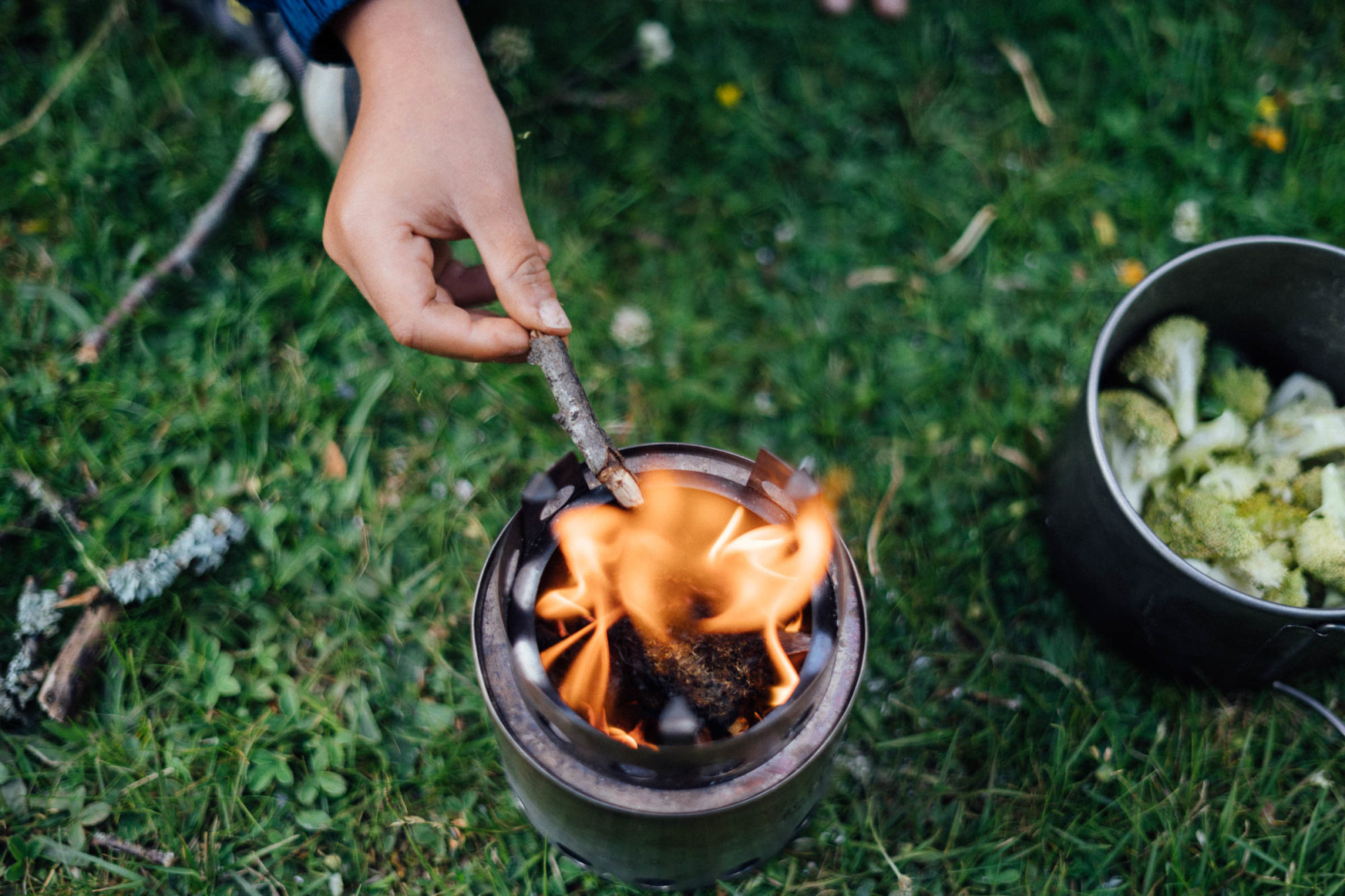
Time On Time Off
I always consider family bikepacking trips as much about time spent off the bike as time spent on it. We kept our distances modest, at 30 to 40 kilometres a day, depending on the terrain we encountered and how much of it Sage was cycling solo. We stopped regularly to explore the forest by foot, or clamber on rocks, climb trees, converse with horses, or study druid stones.
This mindset was also the reason we carried a wood burning Solo Stove as a backup to our Trangia alcohol one, which is also fairly child-friendly. Sage found it fun to forage for kindling, twigs, and dry cow pats and cooking on it becomes an engaging, learning experience. I’m wary of building fires unless necessary; the wood burning stove has the same echoes and a similarly soul-satisfying flicker of flames, without the impact on the soil around it. Similarly, we share the decision about where best to spend the night and share camp duties; Sage and I tend to put the tents up and make a start on inflating the air mattresses, while Nancy gets going on the cooking.
Family Packlist (Core gear)
Sleeping
- Tarptent Double Rainbow for Nancy and Sage
- Tarptent Bowfin for me
- 3 x air mattresses; thick, comfy ones
- 3 x down sleeping bags; lightweight summer models
- Pillows courtesy of clothes
Cooking
- Clikstand/1.2L Evernew ti pot/Trangia alcohol burner
- Solo Stove Lite w/ Alpkit Myti900 pot
- Denatured alcohol + twigs, leaves, dry cowpats
- Scrubbing brush courtesy of grass
- 2 x Sea to Summit X-Seal collapsible bowls
- 3L Hydrapak water bladder; for camping and when water was scarce/days were hot
We bought food locally – corn bread, rice cakes, delicious goat’s cheese, chorizo, olive oil, pasta, polenta, vegetables, granola, fruit, dark chocolate, and regional honey were our staples. We supplemented these with a few backup Firepot dehydrated meals, now available in compostable pouches. And we indulged in ‘pintxos’ – Basque for tapas – when the opportunity arose. Oh, and the area has great ice cream too! We didn’t need to carry a water filter, as there’s plenty of clean water fountains and taps in this region of Spain.
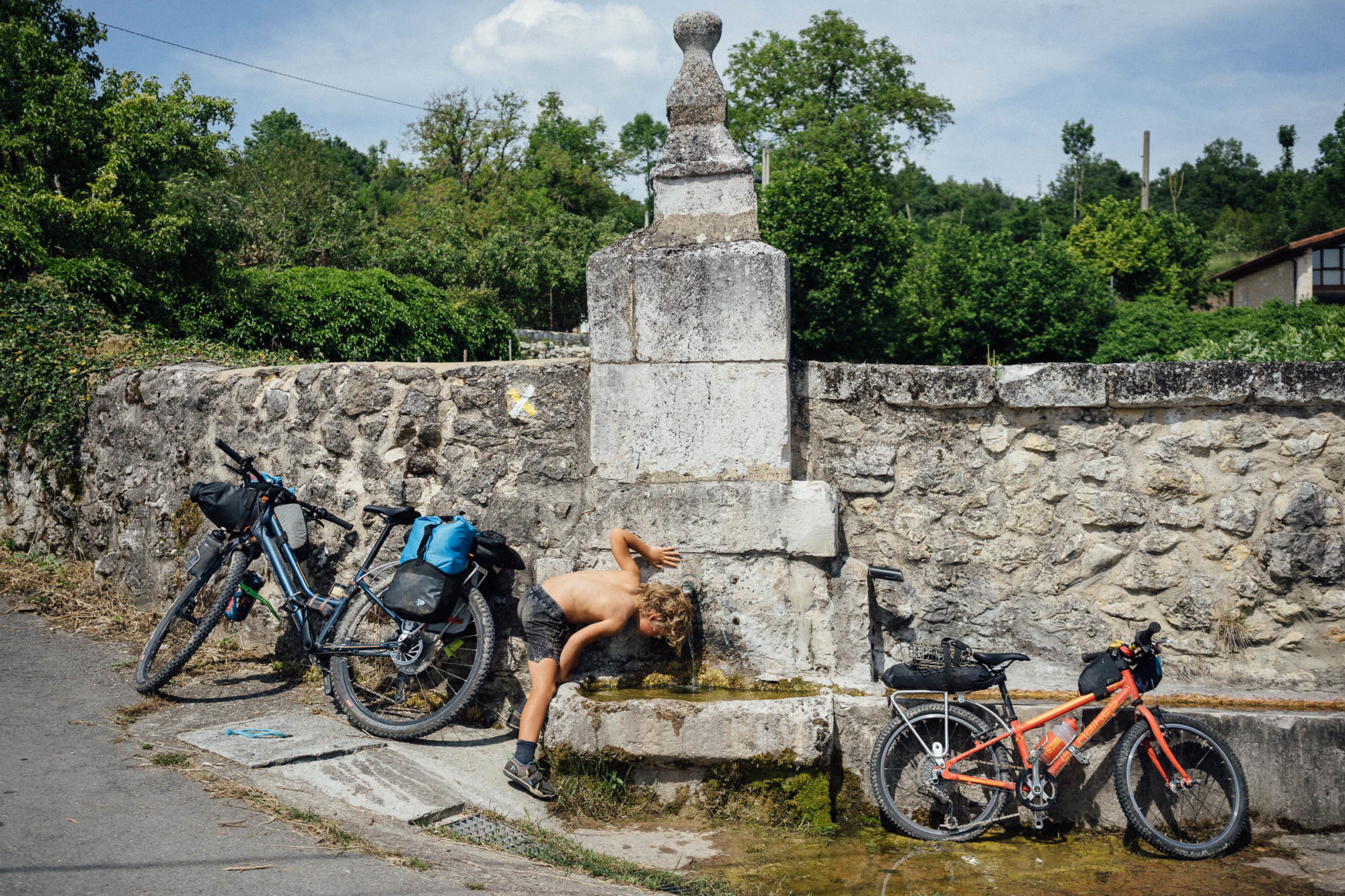
Our Rigs
On a family trip, it’s a balance between paring gear down to a minimum and living simply, and allowing room for the little extras that keep your child happy. That might mean a bedtime book, some Legos, a frisbee, a football, or space for collecting curiosities along the way. Given the often slow rate of progress, hauling extra food and water is frequently required; healthy sustenance is key to daily recovery so we always carry plenty of vegetables and take the time to cook nutritious dinners. For these reasons, a combination of bikepacking gear and small panniers often makes sense.
Nancy rode a Islabikes Jimi. Technically, it’s designed for older riders, but the low gearing and ultralight weight make it good for touring too, so long as you’re happy sacrificing some framebag space, which is often fairly insignificant on smaller bikes. She teamed it with a set of Porcelain Rocket’s Microwave panniers and an Ortlieb handlebar roll. She either rode with a Pack NW hip pack, or attached it to the front of her bike.
I loaded up the Jones SWB with my usual BXB Goldback front bag, along with a Porcelain Rocket 52Hz framebag, and a Tailfin’s carbon rack and pannier system, which I’m testing out. I’d have gone with a more practical tire, like Schwalbe’s G-One 27.5 x 2.8″, but I didn’t get round to changing them out in the rush before the trip. On a general note, I like a wide tyre on family trips as it helps keep the bike grounded, which is useful when towing a load, or carrying a significant weight on a rough descent.

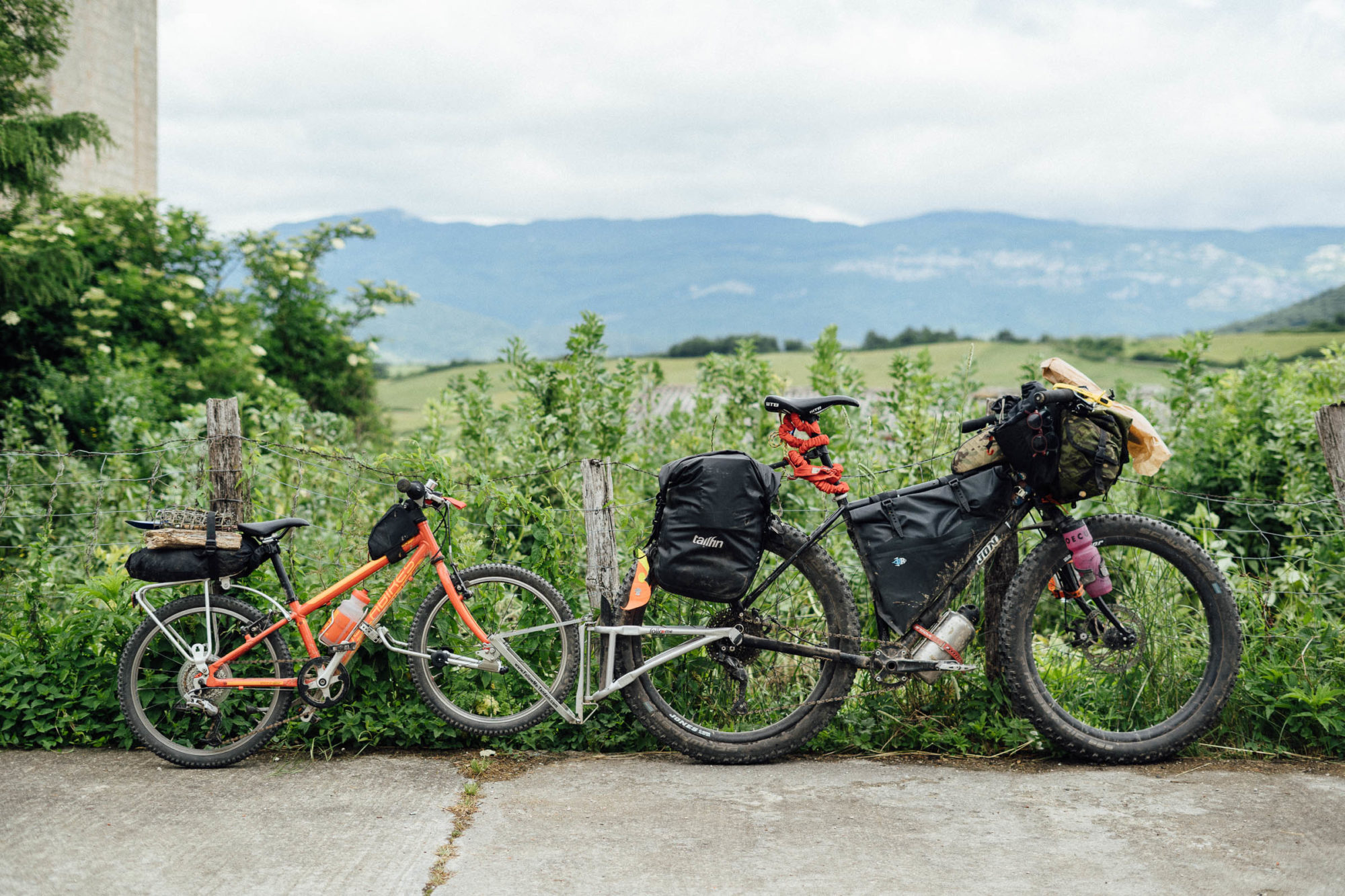
Sage’s Rig
I’m a big fan of kids bike pioneer Islabikes, not least because of their groundbreaking Imagine Project, in which bicycle production of the near future will be part of a closed-loop process. In the meantime, the attention to detail of the current range of children’s bikes is well known amongst those who value design, longevity, and quality.
Sage was lucky enough to borrow a Beinn 20 in a size small for our trip to France and Spain. We set it up with knobbly tyres and a rear rack, on which he carried our Tarptent Double Rainbow and a trowel (good for the beach and #leavenotrace). In part, I figured hauling a light load would give him a sense of purpose within the family team, though the rack was also useful for collecting interesting sticks and other road finds that warranted further examination. He wrapped a lightweight Decathlon hip pack (or Boom Pocket, as we call it) around his waist, or hung it off his handlebars; a place to stash sunglasses, bike gloves, and sundries. He also inherited one of my old Porcelain Rocket top tube packs, filled with valuable Nuun hydration tablets, shells, stones, seeds, and whatever else caught his eye.
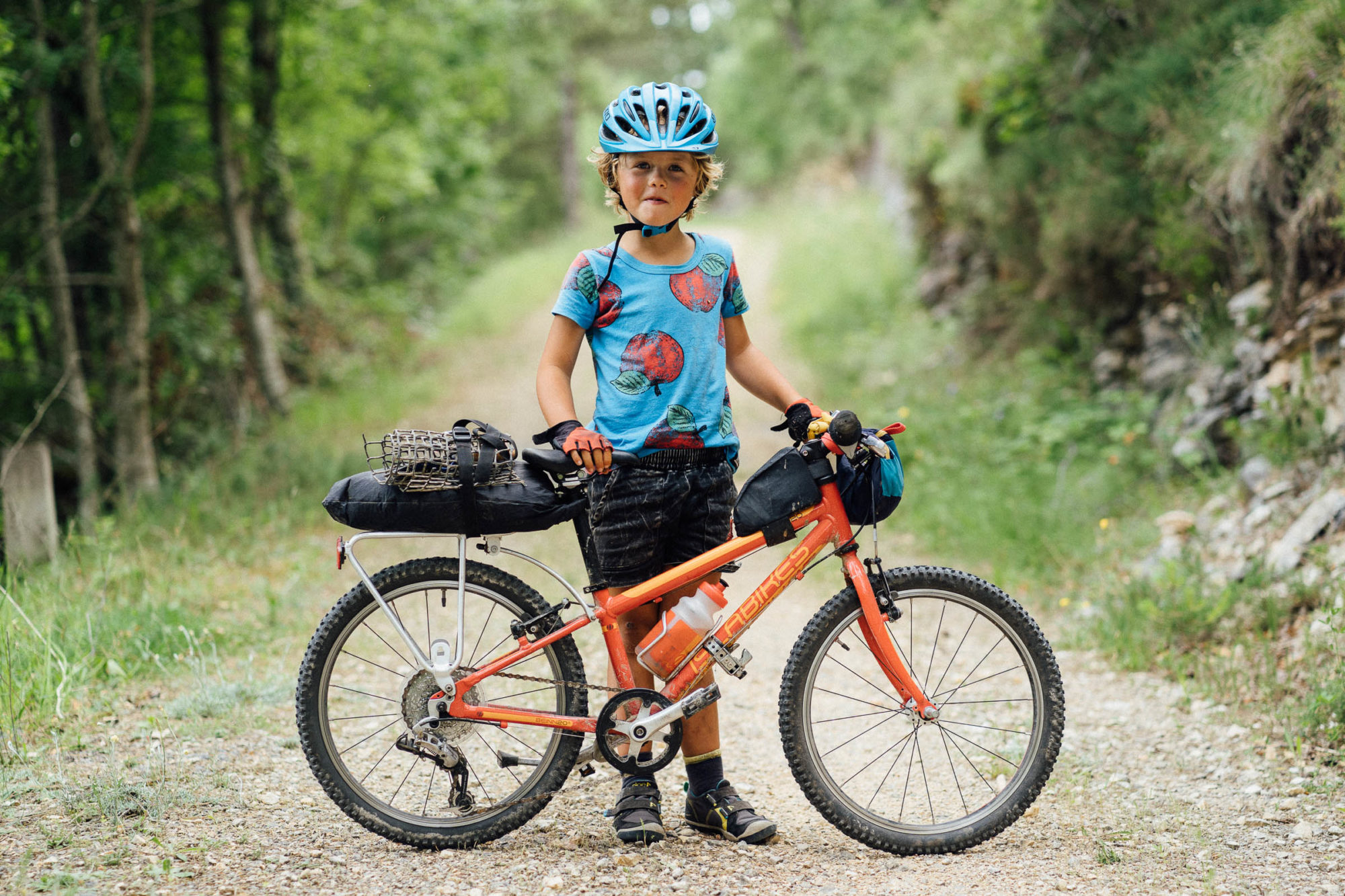
Sage’s Packlist
- Simply Merino wool long underwear top and bottom (aka PJs)
- Smartwool socks (if cold at night)
- Comfortable shorts (riding)
- Cotton t-shirt
- Long sleeve t-shirt
- Tank Top
- 2 x underwear
- Pair of socks
- Shoes (Plae brand)
- Puff Jacket (Patagonia brand)
- Sandals
- Rain shell
- Bamboo toothbrush, toothpaste, hand sanitiser
- Alpkit Snapwire Foon; ti foldable spork
- Small Opinel knife, used under supervision
- Front and rear LED
- Reflective vest
- Decathlon small hip pack
- Bike gloves
- Bike helmet
- Reading book; Harry Potter
- Audio books, on our phones
- Various road finds
- Aerobee
- Extra cord and carabiners for entertainment en route
This was part of a longer trip and summer touring meant no need for a headlamp or warm gloves, pants, or rainpants. If we’d have needed anything, we’d likely have ducked into a Decathlon store.
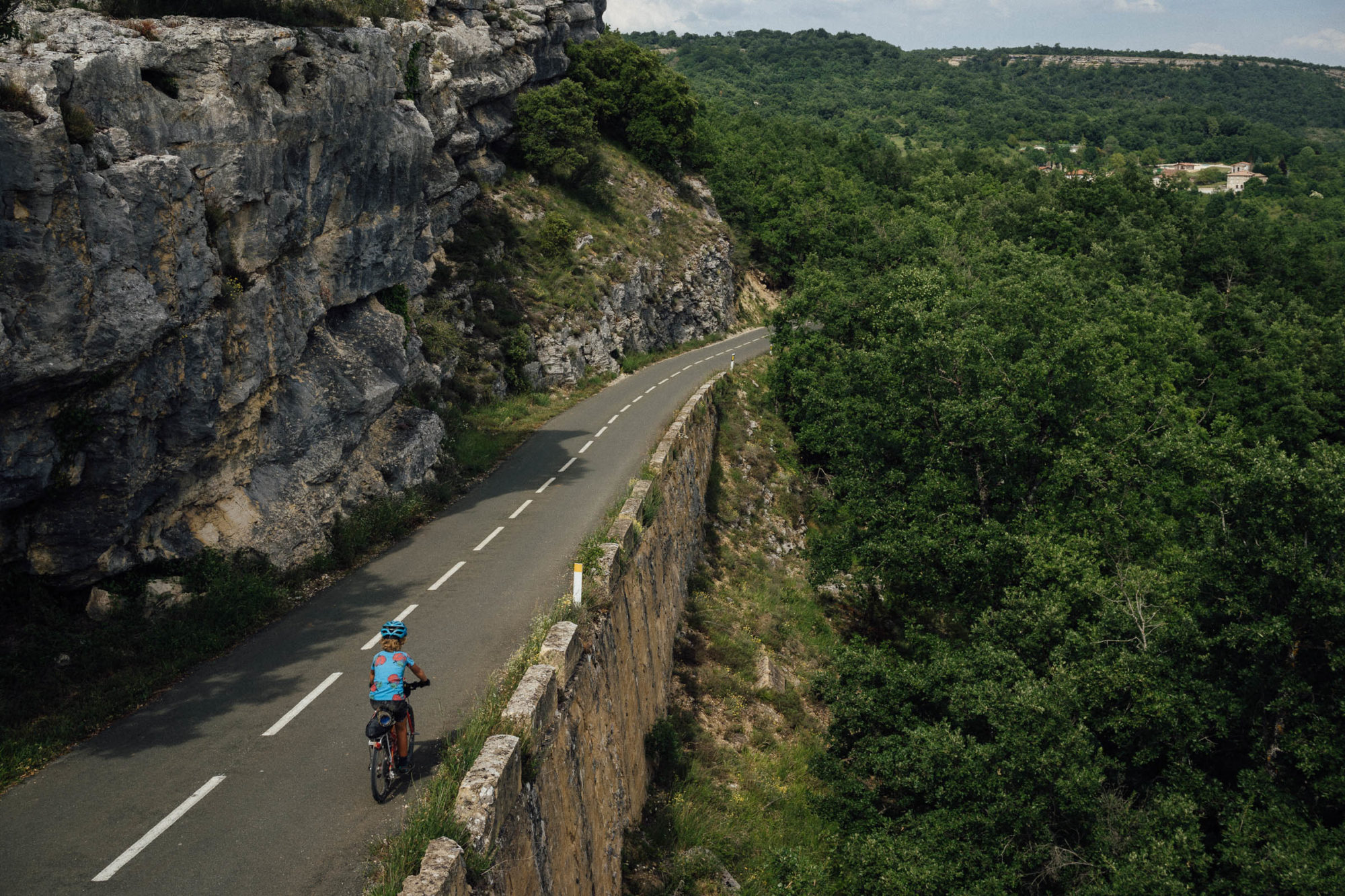
Mini Vuelta de Vasco For Families Map Beta
We didn’t tackle the whole loop, but I’d say the portion from San Sebastian to Vitoria Gastaiz – basically, the Sierra de Aralar and the Sierra de Urbasa – is pretty much ideal for adventurous family bikepacking, as long as you’re happy with a couple of significant road climbs and a few steep off-road pitches. They can be treated as a full crossing, or split into two using public transportation.
For the most part, the riding is along quiet forest roads and bike paths, bar the road climbs into the Sierra de Aralar and the Sierra de Urbasa that see traffic (expect more at the weekends). We found drivers very courteous, but put a reflective vest for Sage when appropriate for peace of mind. A daytime rear LED is handy to have, too. Note that some surfaces are fairly rough and steep in places, with water drainage ditches to look out for. There’s also a little singletrack leaving Róitegui, and a few very short hike-a-bikes in the same area.
It can get extremely hot in the summer, which can make it challenging outside of the cool climes of the forest. Many of the linking sections use Spain’s excellent Vías Verdes – gravel roads that follow old train lines. San Sebastian, Vitoria Gastaiz, and Bilbao are big cities, but they all have an excellent cycling infrastructure that keeps you away from traffic much of the time, particularly Vitoria Gastaiz. Throughout the route, there’s plenty of scope for exploring the moss and lichen-coated forests on foot, which helps to break up hours in the saddle. Summers are warm and nighttime temperatures are never too cold. Just bear in mind that there’s a reason why the area is so lush and green; be prepared for heavy rain and even hail at times.
Summer riding means long days and lingering evenings, so there’s never any rush to get started too early or feel pressured throughout the day. We tend to think 30 km is a good distance if Sage is pedalling most of the time. But we’re happy with 20 km too, or can cover 40 km if need be. On the whole, there’s good access to food and water, though Sundays can leave you stranded, so plan accordingly.
The full crossing of the Sierra de Aralar and the Sierra de Urbasa (see map below) has a few alternates from the Vuelta de Vasco and extra notes – paved roads, playgrounds, water points, smaller cafes for snacks etc. The singletrack sections are also marked, so if you’re travelling with a trailer, you can reroute around them.
The full crossing takes around five to six days with a child; Arbizu makes a good halfway point with a hotel for day off the bike if need be. You can also split the route in two (as described in this post) and treat both as separate rides: a loop up and into the Sierra de Aralar (three days) or a crossing of the Sierra de Urbasa (four days). Train stations are marked too. San Sebastian makes a great town to spend a few days exploring or lounging on the beach, with good connections to both city of Bilbao and France, just across the border.
There are formal campsites in the area. Officially, wild camping isn’t permitted in the parks, but it’s tolerated so long as you pitch your small tent late, leave early, you’re discreet, and you leave no trace. Opportunities abound. This took away the pressure of having to rush from one place to the next, and afforded us some wonderful, peaceful nights’ sleep; just make sure that you pitch where horses and cows won’t trample over you! And bring your earplugs, as the mountain soundtrack reverberates with their ringing bells, day and night.
FollowMe Tandem vs. TowWhee
For this trip, we ran a FollowMe Tandem attached to my bike, a Swiss-made device that allows a child’s bike to be hooked up to an adult’s and towed along while they pedal or freewheel. A step along a child’s evolutionary cycling ladder from a tag-along, it’s ideal for bike tours where your child is confident enough to ride by themselves, but there’s also occasional traffic to contend with, be it stints on main roads or navigating cities that lack bike-friendly infrastructure. When conditions are quiet enough, the child’s bike can be quickly detached for solo travel. It’s a great first step into fully autonomous bike touring for your child, with the safety net of attaching them when the little ‘un may be running out of steam or you need to hurry to a particular spot.

However, as useful as it is, the FollowMe is rather heavy and somewhat cumbersome. All of its 5 kg heft is below the rear axle, which makes the lead bike heavy to lift, especially with panniers. And, it’s not ideal for anything rougher than forest roads. We’d discovered the TowWhee earlier in the year and this trip was the first chance we really had to put it to the test. We nicknamed it the Magic Bungee: a lightweight rubber band in a protective, pleated nylon sleeve, that stretches from 142 cm to 457 cm. This means that when your child is close behind you, it doesn’t drag on the floor, and when he or she is further back, it stretches gently to give them space to manoeuvre and a supporting tug. It’s light and very quick to fit. I’ll write up a separate review later, but for now suffice to say the TowWhee is a game changer in the world of off-road, family bikepacking. Compared to the FollowMe, it has the handling on the lead bicycle far less, making it ideal off road. Whilst the FollowMe has served its time and we’ve been grateful to have it, from now on it will be the lightweight TowWhee that will be joining us on all of our trips.
Seeing as this trip was part of a longer journey that involved both extended road and off-road riding, as well as a ride across Paris, it was useful to have both. Whether you need both will depend on where your child is in his/her cycling, and where you are riding, and across what kind of terrain.

#OneLessFlight
As we were based in the UK for the summer, we set out the intention of only travelling by bike, boat, and train – no flights, despite the added cost. We did this both for environmental reasons and because we wanted all our transportation to become part of the experience from the get-go. It worked out really well and served as a great reminder that you can have a real adventure without needing to fly, even if it means allowing more time for this component of your holiday. Granted, ferries aren’t always the most environmentally friendly way to travel either, but they’re an improvement over flying, and they’re certainly a lot more fun!
In Spain, bikes either travel for free on local trains – typically, there’s lots of space – or have to be booked for intercity trains, where there are only a few spots. Compared to the UK, we found costs very reasonable, plus kids less than six travel for free! As for buses within the region, bikes are stowed in the hold below and are charged at €5 each. To get home, we booked a cabin in an economy ferry with Brittany Ferries for the 28-hour journey between Bilbao and Portsmouth; there are options via Plymouth and Santander too. It was £308 for the three of us, including our bikes and a cabin with a bathroom and an outside facing window.
Figuring out bike policies within Europe can be a complicated process. Thankfully, Seat 61 has an excellent page that helps decipher the various options.
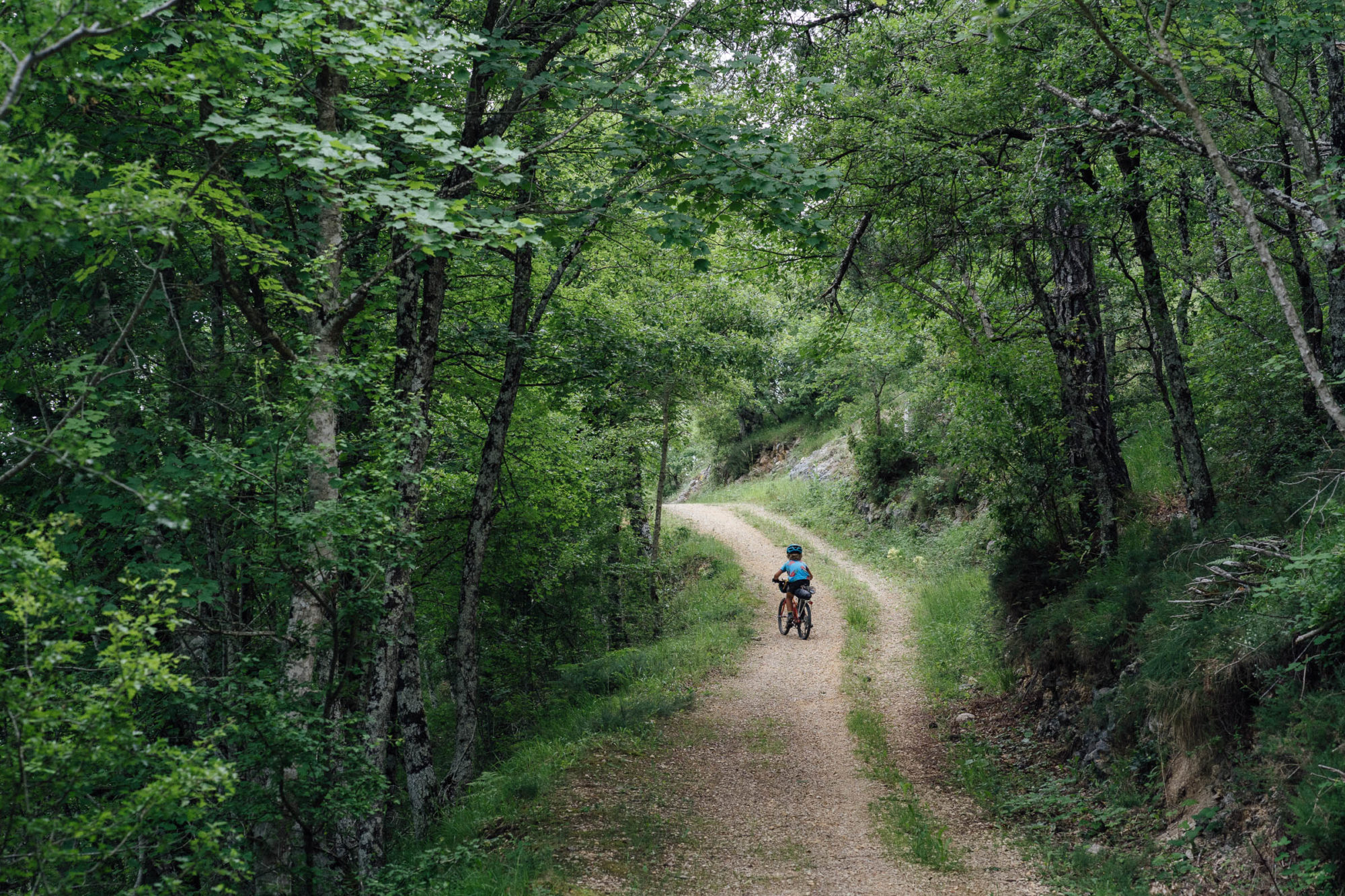
We also rode the Vuelta de Vasco’ segment between San Sebastian and Urbasa, crossing the Sierra de Aralar, another highlight of the route. Sage and I enjoyed it as our first father/son bikepacking trip, and I wrote a story about our experiences for the upcoming third issue of The Bikepacking Journal!
Please keep the conversation civil, constructive, and inclusive, or your comment will be removed.






